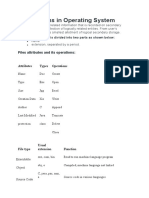0% found this document useful (0 votes)
32 views2 pagesContiguous Allocation in File Systems
Contiguous allocation is a file storage method that keeps all parts of a file in one continuous block on a disk, making it simple to implement and fast for access. However, it faces challenges such as difficulty in finding free space and external fragmentation, leading to its decline in use in modern file systems. As a result, contemporary systems prefer alternative allocation methods like linked or indexed allocation.
Uploaded by
pujarinidhi3Copyright
© © All Rights Reserved
We take content rights seriously. If you suspect this is your content, claim it here.
Available Formats
Download as PDF, TXT or read online on Scribd
0% found this document useful (0 votes)
32 views2 pagesContiguous Allocation in File Systems
Contiguous allocation is a file storage method that keeps all parts of a file in one continuous block on a disk, making it simple to implement and fast for access. However, it faces challenges such as difficulty in finding free space and external fragmentation, leading to its decline in use in modern file systems. As a result, contemporary systems prefer alternative allocation methods like linked or indexed allocation.
Uploaded by
pujarinidhi3Copyright
© © All Rights Reserved
We take content rights seriously. If you suspect this is your content, claim it here.
Available Formats
Download as PDF, TXT or read online on Scribd
/ 2
































































